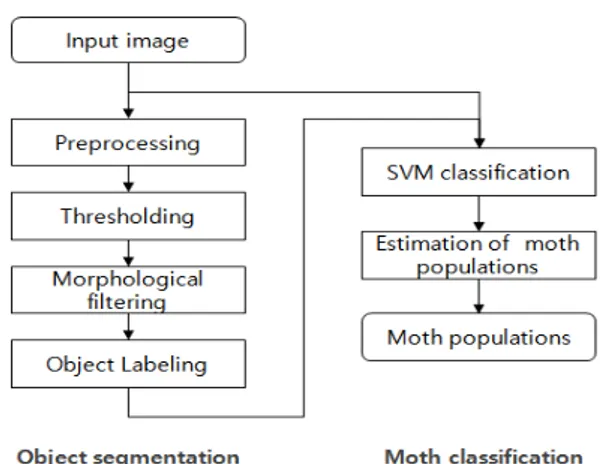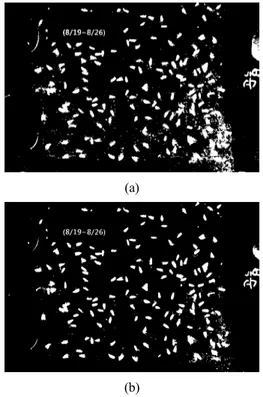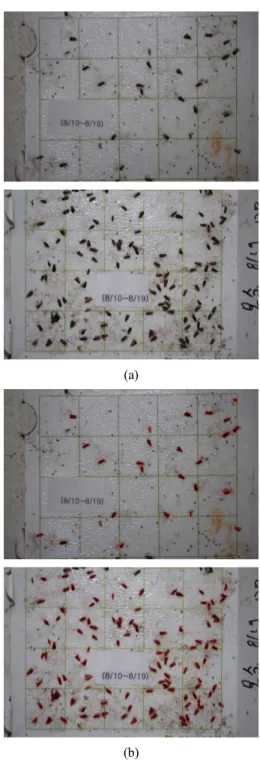Vol. 18, No. 11 pp. 705-710, 2017
객체 분할과 SVM 분류기를 이용한 해충 개체 수 추정
홍영기1*, 김태우2
1농촌진흥청 국립농업과학원, 2한양사이버대학교 전기전자통신공학부
Estimation of Populations of Moth Using Object Segmentation and an SVM Classifier
Young-Ki Hong
1*, Tae-Woo Kim
21Rural Development Administration, National Institute of Agricultural Sciences
2Division of Electrical, Electronic and Communication Engineering, Hanyang Cyber University
요 약 본 논문에서는 해충 영상에서 객체 분할과 SVM 분류기를 이용한 복숭아순나방의 개체 수 추정 방법을 제안한다.
과수원에 설치된 페로몬 트랩에 수집된 복숭아순나방 영상에 대해 객체 분할과 개체 분류를 수행하였다. 객체 분할은 전처리, 문턱치 처리, 형태학적 필터링, 객체 레이블링 과정으로 구성된다. 해충 영상에서 복숭아순나방의 개체 분류는 SVM 분류기 의 학습과 개체 분류, 개체 수 추정 단계로 구성된다. 객체 분할은 SVM 분류기에 입력하기 전에 객체들을 분할함으로써 개체 분류 단계에서 처리 과정을 단순하게 해 준다. 분할된 객체들에 대해 중심점과 주축을 중심으로 영상 블록을 추출하여 SVM 분류기에 입력한다. 실험에서 10개의 해충 영상에 대해 복숭아순나방의 개체 수 추정 결과 97%의 평균 추정 정확도를 보임으로써 과수원에서 복숭아순나방의 개체 모니터링 방법으로서 효과적임을 보였다. 또한 제안한 방법의 처리 시간은 평 균 2.4초, 슬라이딩 윈도우 방식은 5.7초로 본 논문의 방법이 약 2.4배 정도 처리 시간이 빠름을 보였다.
Abstract This paper proposes an estimation method of populations of Grapholita molestas using object segmentation and an SVM classifier in the moth images. Object segmentation and moth classification were performed on images of Grapholita molestas moth acquired on a pheromone trap equipped in an orchard. Object segmentation consisted of pre-processing, thresholding, morphological filtering, and object labeling process. The classification of Grapholita molestas in the moth images consisted of the training and classification of an SVM classifier and estimation of the moth populations. The object segmentation simplifies the moth classification process by segmenting the individual objects before passing an input image to the SVM classifier. The image blocks were extracted around the center point and principle axis of the segmented objects, and fed into the SVM classifier. In the experiments, the proposed method performed an estimation of the moth populations for 10 moth images and achieved an average estimation precision rate of 97%. Therefore, it showed an effective monitoring method of populations of Grapholita molestas in the orchard. In addition, the mean processing time of the proposed method and sliding window technique were 2.4 seconds and 5.7 seconds, respectively. Therefore, the proposed method has a 2.4 times faster processing time than the latter technique.
Keywords : Estimation of moth populations, Grapholita molestas, Moth image, Object segmentation, Pheromone trap, SVM classifier
본 논문은 농촌진흥청 연구사업(세부과제번호: PJ01053803)의 지원에 의해 이루어진 것임.
*Corresponding Author : Young-Ki Hong (Rural Development Administration.) Tel: +82-10-7102-6318 email: sanm70@korea.kr
Received October 11, 2017 Revised October 26, 2017 Accepted November 3, 2017 Published November 30, 2017
1. 서론
복숭아순나방은 복숭아, 사과, 배, 자두 등의 과수원 에서 과실을 직접 가해하는 경제적으로 매우 중요한 해 충들이다[1]. 복숭아순나방의 피해를 줄이기 위해서는 효과적인 방제가 중요하며, 이를 위해서는 과수원에 분 포하는 복숭아순나방의 개체수를 모니터링하는 것이 필 요하다. 복숭아순나방의 개체 수집은 성페로몬 트랩[1]
을 사용하는 방법이 사용되고 있다.
개체 검출을 위해 영상처리를 이용한 국내의 연구는 벼멸구류 밀도측정[2], 볼록총채벌레 자동판정[3] 등이 발표되어 있다. 국외 연구는 SVM (support vector machine)[4], ANN (artificial neural network)[5], KNN (k-nearest neighbors)[6] 등의 방법들이 연구되었다. 특 히 ANN 방법 중 딥러닝(deep learning)을 적용한 해충 자동 검출방법[5]은 과수원에서 촬영된 해충 개체 영상 들에 대해 적용하였다. 이 방법은 슬라이딩 윈도 방식 (sliding window approach) [5]을 적용하고 있는데, 이는 해충 개체를 검출하기 위해 영상 전체를 탐색하는 방식 이다. 영상 전체에 대해 탐색해야 하므로 탐색하는데 처 리 시간이 오래 걸린다.
본 논문에서는 객체 분할과 SVM 분류기를 이용하여 과수원에서 성페로몬 트랩으로 수집된 복숭아순나방 영 상에 대해 개체 수를 자동으로 모니터링 방법을 제안한 다. 이 방법은 크게 객체 분할(object segmentation)과 해 충 개체 분류(moth classification) 과정으로 구성된다.
객체 분할 단계에서는 전처리, 문턱치 처리, 형태학적 필 터링, 레이블링 처리를 하며, 해충 개체 분류 단계에서는 SVM 학습, SVM 분류, 개체수 추정단계로 구성된다. 객 체 분할 단계에서 분할된 객체들은 SVM 분류기로 입력 하여 해충 개체를 인식한다. 객체 분할 단계에서 객체에 대한 정보를 추출하여 개체 분류 단계에서 이용함으로써 개체 인식을 위한 처리 속도를 높여준다.
제2장에서는 본 논문의 복숭아순나방의 개체 수 추정 방법에 대해 논한다. 제3장에서는 제안한 방법에 대한 실험 결과에 대해 다루고, 제4장에서 결론을 맺는다.
2. 복숭아순나방의 개체 수 추정 방법
복숭아순나방의 실제 모습과 촬영된 영상의 모습은 Fig. 1에 보여준다. 영상에서는 주로 어두운 색상을 보이
며, 자세는 대체로 날개를 접은 상태가 많으나, 날개를 펴거나 누운 자세도 종종 나타난다.
복숭아순나방의 개체 수 추정을 위한 본 논문의 방법 은 Fig. 2와 같이 객체 분할과 개체 분류단계로 구성된 다. 객체 분할은 전처리, 문턱치 처리, 형태학적 필터링, 객체 레이블링 과정[7]으로 구성된다. 개체 분류 단계에 서는 SVM 분류기를 먼저 학습시킨 후, SVM 분류기로 단일 개체를 분류한다. 단일 개체가 아닌 경우에는 면적 에 기반하여 개체의 수를 추정한다.
(a)
(b)
Fig. 1. (a) Appearance and (b) trap image of Grapholita molesta.
Fig. 2. Flow chart of the proposed method of estimation of moth populations of Grapholita molestas.
2.1 객체 분할 2.1.1 영상의 전처리
복숭아순나방 영상의 전처리는 Fig. 3과 같이 RGB 컬러를 HSI 컬러로의 변환과 필터링[7]으로 잡음을 제 거하는 과정이다.
(a)
(b)
Fig. 3. Pre-processing of moth image of Grapholita molesta: (a) intensity component image after transforming the image into HSI color space, and (b) the image after noise removal.
2.1.2 문턱치 처리
문턱치 처리는 히스토그램 기반 방법인 Otsu의 방법 [8]으로 처리한다. Fig. 4는 입력된 영상에 대한 전형적 인 히스토그램을 보여준다. 문턱치 처리는 전역적 방법 (global method)으로서 최적의 문턱치를 결정한다.
Fig. 5는 문턱치 처리를 한 결과를 보여준다. Fig. 5 (a)는 최적 문턱치 보다 약간 높은 문턱치로 처리한 결과 이고, Fig. 5 (b)는 Otsu의 방법[8]으로 최적 문턱치로 처 리한 것이다.
2.1.3 형태학적 필터링
형태학적 필터링은 형태학적 열기(morphological opening) [7]를 적용한다. 이를 통해 미소 객체들이 제거
되고, 약하게 붙은 객체들은 분리된다. Fig. 6은 형태학 적 필터링을 한 결과를 보여준다.
Fig. 4. Typical histogram used for thresholding of a moth image.
(a)
(b)
Fig. 5. Thresholding: (a) thresholding by higher threshold compared to the optimal threshold, and (b) an optimal thresholding.
2.1.4 객체 레이블링
형태학적 필터링을 통해 얻어진 객체들에 대해 레이 블링(labeling) 처리를 진행한다. 레이블링은 각 객체가 분리 인식될 수 있도록 해 준다. Fig. 7은 분리된 객체들 에 대해 레이블링 처리를 한 결과를 보여준다.
2.2 개체 분류
개체 분류는 분리된 각 객체들에 대해 SVM 분류기로 분류하는 단계이다. 먼저 단일 해충으로 된 해충 개체를 분류하고, 그 이외의 객체들에 대해서는 다중 해충 개체 들로 분류해 낸다. 최종적으로 해충 개체의 수는 단일 해 충 개체와 다중 해충 개체로부터 추정된다. SVM 분류 기는 학습과정과 분류과정으로 구성된다.
(a)
(b)
Fig. 6. Morphological filtering: (a) small spot removal and (b) morphological opening.
Fig. 7. Labeling of morphological filtered objects.
2.2.1 SVM 분류기의 학습
SVM 학습에 사용되는 데이터는 샘플 영상들로부터 객체를 분할하여 만든다. Fig. 8과 같이 분리된 객체들에
대해 중심점과 주축을 계산한다. 객체들의 중심점을 중 심으로 하여 일정한 방향으로 주축을 정렬한 후, 31×31 크기의 영상 블록(image block)을 추출한다. 중심점을 기준으로 주축을 정렬하면 SVM 학습에 사용되는 학습 패턴의 종류와 수를 줄일 수 있다.
학습에 사용되는 패턴은 Fig. 9와 같이 분할된 단일 관심 개체 패턴, 다중 관심 개체 패턴, 관심 개체가 아닌 패턴 그룹으로 나뉜다.
(a)
(b)
Fig. 8. Extraction of training patterns for an SVM classifier: (a) extraction of centers and principle axises of the segmented objects, and (b) extracted image blocks as training patterns.
(a)
(b)
(c)
Fig. 9. Training patterns for an SVM classifier: (a) single moth patterns, (b) multiple moth patterns, and (c) the other patterns.
2.2.2 SVM 분류기의 해충 개체 분류
학습 패턴으로 학습된 SVM 분류기에 분할된 객체들 의 영상 블록을 입력하여 개체를 분류한다. 이를 위해 입 력된 영상에 대해 먼저 객체를 분할한다. 분할된 객체에 대해 중심점과 주축을 구하여 중심점을 중심으로 주축을 정렬한다. 중심점을 기준으로 31×31 영상 블록을 추출 하여 SVM 분류기로 입력하게 된다.
2.2.3 개체수 추정
SVM 분류 과정에서 단일 개체로 분류된 경우에는 대 상 해충 개체로 최종 분류하게 된다. 단일 개체가 아닌 다중 개체의 경우에는 다중 개체의 면적에 단일 개체의 평균 면적을 나누어 추정하게 된다. Fig. 10은 개체수 추 정 결과를 보여준다.
Fig. 10. Estimation of moth populations of Grapholita molestas: objects of red contours represent single or multiple interest moths.
3. 실험결과 및 토의
실험에 사용된 복숭아순나방 영상은 해상도가 640×480인 10개를 사용하였다. 이들 영상은 사과 과수 원에서 페로몬 트랩으로 해충을 수집하여 실험실에서 촬 영한 것이다. 촬영에 사용된 카메라는 Cannon EOS 40D 이고 해상도가 3888×2592인 영상을 저해상도로 변환한 것이다.
이들 영상에 대해 영상 분할과 개체 인식을 통해 해충 의 개체 수를 추정하였다. 개체 인식의 예는 Fig. 11과 같다. 개체 수 추정율은 전문가에 의해 개체수를 조사한 것을 기준으로 계산한 것이다. 평균 추정율은 Table 1과 같이 97%로 나타났다.
본 논문의 방법인 객체 분할 방법의 처리 시간은 2.4 초, 슬라이딩 윈도우 방식은 5.7초로 본 논문의 방법이 2.4배 정도 처리 시간이 빠름을 보였다.
(a)
(b)
Fig. 11. Typical estimation of moth populations of Grapholita molestas: (a) input images and (b) estimated interest moths.
No 1 2 3 4 5 6 7 8 9 10 Tota l Correct
populations 156 27 110 3 5 2 2 4 22 21 352 Estimated
populations 150 25 110 3 5 2 2 4 20 19 340 Rate(%) 96 93 100 100 100 100 100 100 91 91 97 Table 1. Estimation of moth populations of Grapholita
molesta.
4. 결론
본 논문은 해충 영상에서 객체 분할과 SVM 분류기를 이용한 복숭아순나방의 개체 수 추정 방법을 제안하였 다. 영상에서 객체를 분할함으로써 SVM 분류기의 학습 패턴수를 줄일 수 있고 처리 속도를 향상시킬 수 있었다.
본 논문의 방법의 처리 시간은 2.4초로 슬라이딩 윈도우 방식 보다 2.4배 정도 빠른 성능을 보였다. 또한 제안한 방법이 실험에서 관심 개체 수 추정율이 평균 97%로 복 숭아순나방의 자동 모니터링에 활용될 수 있음을 보였 다. 향후 영상 블록에 다중 개체가 나타나는 경우에 대해 좀 더 정확한 개체 인식방법에 대한 연구가 필요하다.
References
[1] Younggyun Kim, Sungchae Jung, Sungwoo Bae, Bowon Kwon, Hyangmi Yoon, and Yong Pyo Hong, “Factors Influencing Field Monitoring of the Oriental Fruit Moth, Grapholita molesta, with Sex Pheromone”, Korean J.
Appl. Entomol., vol. 46, no. 3, pp. 349-356, 2007.
DOI: https://doi.org/10.5656/KSAE.2007.46.3.349 [2] Young-Seuk Park, Man-Wi Han, Hwang-Yong Kim,
Ki-Baik Uhm, Chang-Gyu Park, JangMyung Lee, and Tae-Soo Chon, “Density Estimation of Rise Planthoppers Using Digital Image Processing Algorithm”, Korean J.
Appl. Entomol., vol. 42, no. 1, pp. 57-63, 2003.
[3] Chang Bae Moon, Byeong Man Kim, Jong Yeol Yi, Jae Wook Hyun, and Pyoung Ho Yi, “Detection of Candidate Areas for Automatic Identification of Scirtothrips Dorsalis”, J Korea Industr Inf Syst Res, vol.
17, no. 6, pp. 51-58, 2012.
DOI: https://doi.org/10.9723/jksiis.2012.17.6.051
[4] Chenglu Wen, Daniel E. Guyer, Wei Li, “Local feature-based identification and classification for orchard insects”, Biosystems Engineering, 104, pp. 299-307, 2009.
DOI: https://doi.org/10.1016/j.biosystemseng.2009.07.002 [5] Weiguang Diang, Graham Taylor, “Automatic moth
detection from trap images for pest management”,
Computers and Electronics in Agriculture, 123, pp.
17-28, 2016.
DOI: https://doi.org/10.1016/j.compag.2016.02.003 [6] Chenglu Wen, Daniel Guyer, “Image-based orchard
insect automated identification and classification method”, Computers and Electronics in Agriculture, 89, pp. 110-115, 2012.
DOI: https://doi.org/10.1016/j.compag.2012.08.008 [7] Hyeon-Joong Yoo, Tae-Woo Kim, and Chun-Seok Oh,
Digital Image Processing, Firstbook, 2013.
[8] Nobuyuki Otsu, “A Threshold Selection Method from Gray-Level Histogram”, IEEE Transactions on Systems, Man, and Cybernetics, vol. 9, no. 1, pp. 62-66, 1979.
DOI: https://doi.org/10.1109/TSMC.1979.4310076
홍 영 기(Young-Ki Hong) [정회원]
•2001년 3월 : 일본 동경농업대학교 대학원 농업공학전공 (공학석사)
•2004년 3월 : 일본 동경농업대학교 대학원 생물환경조절학전공 (공학 박사)
•2004년 4월 ∼ 2006년 3월 : 일본 동경농업대학교 종합연구소 박사후 연구원
•2007년 12월 ∼ 현재 : 농촌진흥청 국립농업과학원 농업 연구사
<관심분야>
영상처리, 패턴인식, 기계학습, 인공지능, 정보통신
김 태 우(Tae-Woo Kim) [종신회원]
•1992년 2월 : 한양대학교 대학원 전자통신공학과 (공학석사)
•1995년 2월 : 한양대학교 대학원 전자통신공학과 (공학박사)
•1997년 3월 ∼ 2003년 2월 : 삼성 종합기술원 U-health팀 수석연구원
•2003년 3월 ∼ 현재 : 한양사이버 대학교 전기전자통신공학부 교수
<관심분야>
영상처리, 패턴인식, 기계학습, 인공지능, 정보통신



